In this article, we’ll discuss in detail why ChatGPT may not be suitable for growing businesses, and how we can still utilize ChatGPT by implementing the right strategies for any business around the world.
ChatGPT is undoubtedly a powerful generative AI model that can assist individuals in writing blogs and articles, summarizing content, and more. Its plugins allow it to work with other applications ( ChatGPT Plus customers) is a fantastic tool that saves a lot of time and effort, making tasks much easier than before. The internet is overflowing with countless prompts, use cases, ideas, and inspiration on how to leverage ChatGPT.
1000’s of new businesses are being built using ChatGPT, and some of my favorites include ChatWithPDF, Write Sonic, Jasper, and the Zapier Plugin, among others. Most of these tools have been developed to fill in the gaps left by the ChatGPT. For instance, ChatWithPDF allows you to directly upload a long PDF file, whereas ChatGPT requires you to copy and paste contents, and it also has limitations on the number of characters. As all these platforms utilize the ChatGPT API, they come with a price tag.
8 Reasons Why ChatGPT Might Not Be the Best Fit for Growing Businesses.
Many businesses around the world have products or services to sell, be it tangible or intangible. To create these products or services, businesses might have invested in various ways. Once a product or service is ready, the next step is to market and sell it to potential customers. We can say that the backbone of any business is the data and communication relevant to its products, services, and processes, and this is entirely unique from one company to the other.
However, it’s important to recognize that AI models like ChatGPT may not always be the best solution for every business, especially growing ones. Here’s why.
1. Data Training & Contextual Limitations: A Major Hurdle for Businesses
Training ChatGPT with business-specific data is a significant challenge many entrepreneurs face. While the AI can provide more contextual answers if given the context each time, its knowledge isn’t up-to-date. This makes training it with a broad set of domain-specific knowledge quite complex. Moreover, ChatGPT doesn’t remember the context of past conversations. For instance, if a customer asks a follow-up question days after your bot provided travel itinerary advice, ChatGPT is unlikely to recognize the context and continue the conversation smoothly.
2. Seamless Integration Challenges: Struggles with Contextual Data Retrieval
Seamlessly integrating ChatGPT into daily-use software to fetch contextual data is another significant pain point. While there are plenty of browser plugins that allow for querying or passing data to ChatGPT, none of them successfully provide the contextual information necessary for businesses. For example, a tool that could analyze a customer’s last 10 purchases and send them suggestions via email or WhatsApp remains a much-needed solution.
3. Cost Concerns: Unanticipated Expenses of Using ChatGPT
Cost is a major stumbling block for many business owners. Often, they’re under the impression that ChatGPT is free, and the detailed billing model, which charges for each input and output, catches them off guard.
For instance, let’s consider using ChatGPT for customer support. To effectively answer customer queries, you’d need to train ChatGPT with all your resources. Suppose you manufacture washing machines, with 100’s of different models. Each model has its own user manual, and if each manual averages 100 pages with 500 words per page, you’d be looking at roughly 50,000 words, or tokens, to pass as assistant data to ChatGPT. If you’re using the GPT3-Turbo 16k model, an input of 50,000 tokens costs you around $0.15, not including the cost for the output.
Assuming the output uses less than 1,000 tokens, the cost per reply will be around $0.15. If a customer asks 20 questions in a conversation, you’d be looking at a cost of $3 for just that one interaction. So, if your bot handles 100 conversations in a day, it will cost you $300 daily, and that adds up to a whopping $9,000 in a month and $1,08,00 in a year 😇
4. Latency Issues: The Impact of Delayed Responses on Customer Satisfaction
Timelag or latency is another major issue for businesses that have integrated ChatGPT. Often, their servers can be overcrowded, leading to average response times of more than 20 seconds or even a complete outage, depending on the data size. This can be problematic, especially if you’re using a bot for customer interactions. Customers are likely to send multiple messages in quick succession if the response isn’t prompt, which can confuse ChatGPT. This not only frustrates the customer but also results in double costs, the cost of using ChatGPT, plus the added cost of human intervention when the case is escalated 🥹
5. Absence of Individual Learning: The Limitations of Non-Contextual Interactions
Despite its name, ChatGPT doesn’t learn from individual interactions. Each conversation is independent of the last, meaning it can’t remember previous interactions or learn from its mistakes. This lack of continuous learning can pose a problem for growing businesses that aim to offer personalized customer experiences. The inability to recall and learn from past interactions limits the depth and personalization of customer engagement.
6. Generation of Irrelevant Content: Unnecessary Costs for Businesses
Another significant issue is ChatGPT’s potential to generate irrelevant content. For example, if your company offers tours and travel services and a user asks about health benefits or a diet plan, ChatGPT is likely to provide generic, non-relevant answers. Not only does this take the conversation off-topic, but you’ll still be billed for this unnecessary and unrelated content. This can lead to unwanted costs and a less focused customer interaction 😭
See one of the provider that provides answers based on the website data that offers Chatbot service still their chatbot provides generic information that is not relevant to what they do.
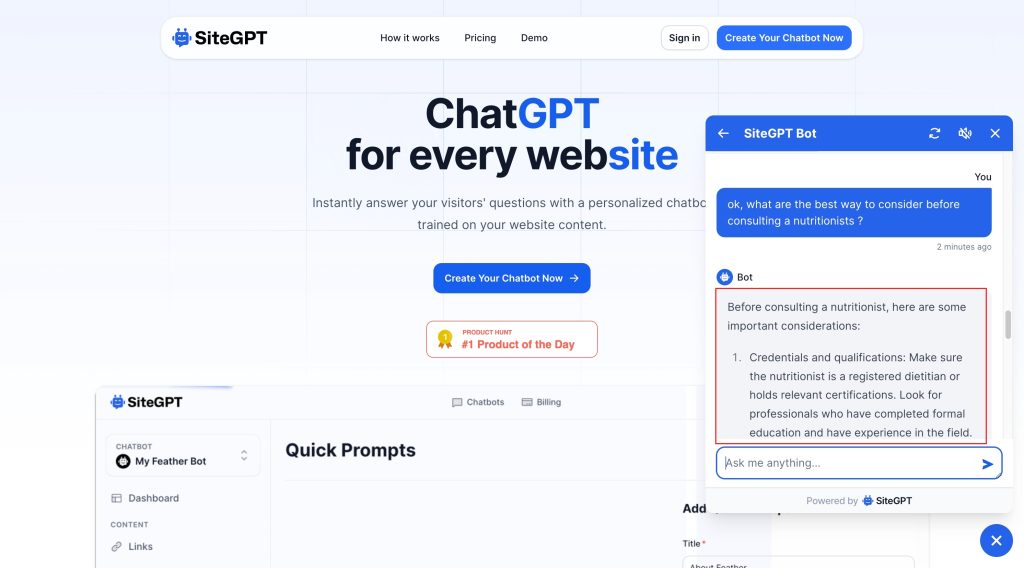
7. Lack of Control over Conversation Frequency: Unnecessary Costs without Added Value
There’s also no control over the frequency of conversations when using ChatGPT, which can lead to high costs without corresponding benefits. For example, if you’re providing wellness consulting services and have a ChatGPT-powered bot integrated into your WhatsApp, Facebook Messenger, and Instagram, any public user can interact with your bot. This might result in a surprising bill from ChatGPT, even though these conversations might not add any value to your sales or processes 😩
8. Diminished Employee Productivity: Overreliance on AI and the Cost to Human Capabilities
An unintended consequence of using ChatGPT is the potential for decreased employee productivity. Your internal staff might start to overly rely on ChatGPT’s responses, even for minor issues. This dependence could lead to increased costs for you and diminished productivity from your employees in the long run. It might also stifle their analytical abilities, as they’re not exercising their problem-solving skills to address queries 🤪
So What’s the Solution to these problems?
Let’s ask the ChatGPT itself 🥹 and here are the solutions
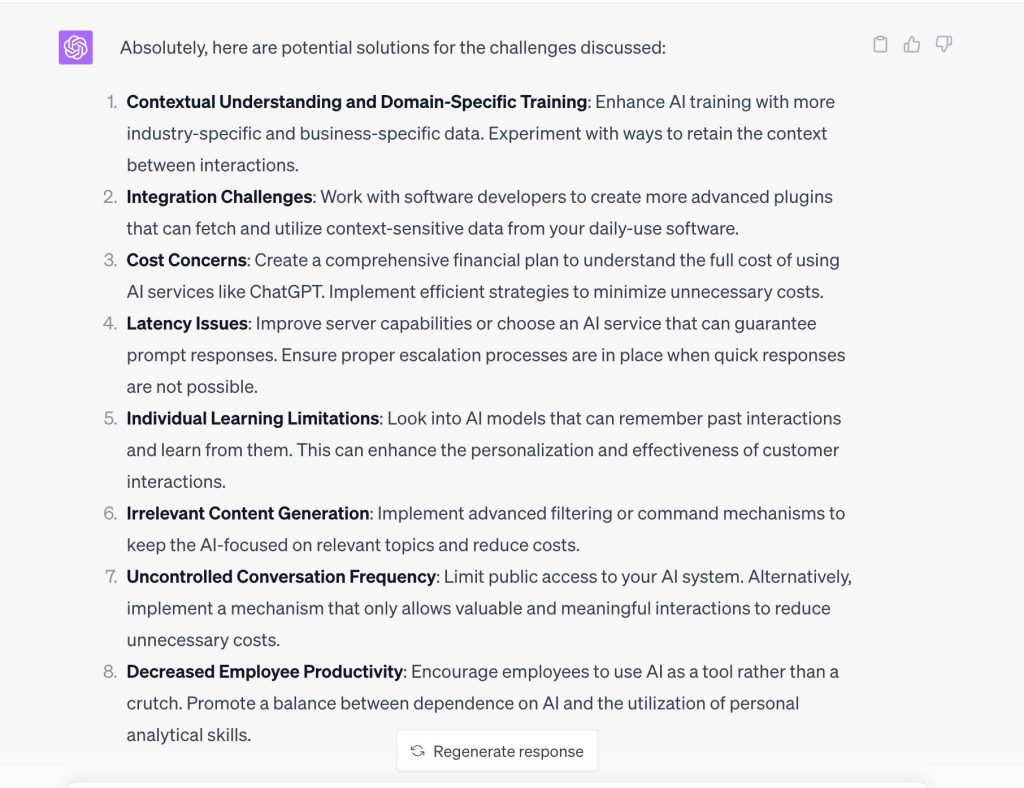
✅ Overcoming Challenges with Picky Assist: A Comprehensive Business Automation Solution
As we’ve highlighted in our opening statement, data and communication form the backbone of any growing business. If an entrepreneur can determine how to use these two elements effectively in their area of expertise, their business is set up for success.
So now, let’s delve into how Picky Assist’s comprehensive business automation solution can help you overcome these challenges.
Picky Assist: Uniting Data and Communication in a Single, User-Friendly Platform
Picky Assist’s core strength lies in its ability to seamlessly integrate data and communication into a single, scalable, and secure cloud platform. Not only is it incredibly easy to use, but it also allows you to go live in less than an hour. Now, let’s dive deeper into how our diverse technologies and products work together in a seamless way to address the aforementioned limitations of ChatGPT.
1. Domain and Process-Specific Training: Case Study of Sayaji Hotel
Picky Assist empowers businesses to train ChatGPT based on your domain specifics and even process-wise. Let’s demonstrate this with an example of how we have assisted Sayaji Hotel. Sayaji is a luxury 5-star hotel chain in India with 14 properties. Their property in Indore has 14 banquet halls, each offering a different area, seating styles, amenities, and seating capacity. We trained the bot using the data available on the website, leveraging ChatGPT’s custom training capabilities. Let’s see how this transformed their backend operations.

2. Connected, Conversational, Minimal Data Entry & Modular CRM
The Customer Relationship Management (CRM) industry has been around as long as computers, so there are plenty of CRM providers on the market that address numerous pain points and automate many repetitive tasks. However, most CRM systems only solve one or two problematic processes, often focusing on streamlining sales.
Picky Assist: A Customizable Modular Solution Tailored to Your Needs
At Picky Assist, we have dedicated 1000’s of hours to research and development, analyzing hundreds of products on the market. The result is a unique platform, built from the ground up, that’s not just agile but also 100% modular. This platform allows businesses to create virtually any use case, be it a Sales CRM, Support Desk, Lead Management, Inventory Management, Marketing Process, Meetings, Payments, Invoicing, Accounting, HRM, or any process that requires streamlined data and communication. The best part? Picky Assist can adapt to any requirement, and you don’t need to write a single line of code for customization.
Stay Connected with Our Inbuilt Connector
Our built-in Connector ensures that your business is always linked with any other software you use. It supports integration into more than 5000 apps and provides developers with the means to build custom connections in less than 15 minutes. This ability ensures your business is always connected. For instance, whenever a payment is made via your partner payment gateway provider, our system can automatically attribute it back to the respective order details and input it into the invoice module to generate an invoice automatically. This seamless integration facilitates better business operations.
Data-Driven Conversations for Personalized Interactions
Our data-driven conversational approach ensures that your business and team are always connected with customers through their preferred channels, such as email, WhatsApp, Facebook Messenger, or Instagram. When your data and customer communication align effectively, more business is likely to occur.
We go beyond the standard generic conversations where only the customer’s name changes. Instead, we make sure each customer receives messages relevant to their needs, interests, and purchase history. This is done using data-driven campaigns tailored to individual customers.
For instance, if you need to clear out old stock, instead of putting up a typical ‘stock clearance’ sign, you can create a targeted campaign. This campaign could target customers who, based on past purchase data, are likely to buy your products even at a lower discount. If the stock isn’t cleared out in a given time, our system can automatically create another campaign targeting a different set of customers, this time offering a higher discount. This approach ensures you make the most profit possible.
3. Balancing AI, Flow and Human Interaction for Cost Efficiency
Relying entirely on AI solutions such as ChatGPT can attract high costs for businesses. Picky Assist offers a unique blend of solutions that ensure businesses utilize the maximum benefits of all available tools in a cost-effective way. Let’s explore how:
Hybrid AI Approach for Cost Reduction
We have a proprietary Semantic AI and a Train Once model, which combined, can substantially lower costs. For instance, consider a washing machine manufacturer looking to provide chat-based customer support. They have a user manual of roughly 100 pages, which can be uploaded onto our platform. We create a semantic index and pair it with probable user intents. If our AI deems the confidence score satisfactory, it responds using the data from our platform. In case the score is not satisfactory, we pass on the information to ChatGPT for a better response. This method minimizes the usage of ChatGPT tokens, lowering costs without compromising on customer resolution quality.
Sentiment Analysis and Human Intervention
During a chat, our system can predict user sentiment, assessing whether they are satisfied or frustrated with the bot’s responses. If frustration or confusion is detected, the chat is immediately transferred to a human agent via our Teambox, along with a contextual summary of the conversation. This saves the agent’s time, enabling them to attend to more users efficiently.
Feedback Collection through Visual Flow Builder
Collecting feedback from customers after human interaction is vital, and this is where our visual flow builder comes into play. After an agent marks the conversation as closed, a predefined flow bot triggers a feedback message either via WhatsApp or email. The responses are then collected and stored back in the respective user profile or transaction record in the CRM.
Picky Assist optimizes the blend of technology and human interaction, balancing cost efficiency with high-quality customer interactions.
4. Addressing Latency Issues for Seamless Customer Experience
The latency issue associated with ChatGPT could potentially result in a less satisfying customer experience, especially if users are seeking immediate responses. Picky Assist addresses this problem using a multi-pronged approach:
Hybrid AI Method
As explained earlier, our hybrid AI method handles 80% of interactions natively without requiring ChatGPT’s involvement. This significantly reduces the chances of latency causing a break in the customer experience.
Automatic Response System
If your business requires a more natural reply and needs to analyze complex data structures before providing an answer, we send an automatic response such as “Please wait, we are analyzing the request. Any further inputs may not be taken into consideration.” This ensures the user is informed and aware that their query is being processed, even during periods of high latency.
Human Intervention
If ChatGPT fails to respond within the configured time, our system automatically transfers the conversation to a human agent. This not only bridges the gap caused by the latency issue but also ensures that customers always receive timely responses.
These measures ensure that latency issues do not hinder the seamless customer experience your business aims to provide.
5. Contextual Conversations for Better Customer Interactions
ChatGPT’s inability to reference previous conversations with a user can pose challenges for businesses aiming for personalized, context-rich interactions. Constantly passing all prior conversations to ChatGPT for context would consume more tokens, leading to higher costs.
Picky Assist addresses this issue with a smart strategy:
Conversation Summarization and Storage
Picky Assist system summarizes every conversation that occurs, whether with a bot or a human agent. These summaries are saved as small chunks of information in the CRM, tied to the respective users. This approach creates a record of past interactions that can provide context for future conversations.
Efficient Utilization of Context
Whenever there’s a need to provide context for a conversation with ChatGPT, this summarized information can be passed instead of the full conversation history. This not only results in a context-rich and meaningful conversation but also reduces token usage, thus saving costs.
With this method, businesses can enhance their customer interactions by maintaining the continuity of conversations across different sessions, all without paying extra for ChatGPT tokens.
6. Minimizing Irrelevant Responses for Targeted Interactions
An acknowledged drawback of using ChatGPT is its potential to provide irrelevant responses. For instance, if your business is a travel agency and a user inquires about dietary plans or nutritionist details, ChatGPT might yield generic answers that are off-topic.
To combat this issue, Picky Assist has implemented a ‘Behavioral Guideline’ system:
Behavioral Guidelines
Businesses can configure strict guidelines regarding the type of responses the ChatGPT is allowed to generate. These guidelines can instruct ChatGPT to stick to the business’s domain of expertise and not to provide information unrelated to that domain.
Continuous Monitoring and Fine-Tuning
The system also incorporates an ongoing process to monitor and fine-tune the behavior of ChatGPT. This ensures that the bot’s responses stay relevant to the business process over time.
With these measures in place, Picky Assist ensures that businesses are able to maintain topical, relevant, and effective conversations with their customers, all while controlling costs. This leads to better customer experience and increases the return on investment from using ChatGPT.
6. Granular Control over Chatbot Interactions to Manage Costs
An acknowledged drawback of using ChatGPT is the lack of control over the frequency of conversations. This lack of control can lead to unexpected costs without corresponding benefits. For example, if you’re providing wellness consulting services and have a ChatGPT powered bot integrated into your social media messaging platforms, any public user can interact with your bot, leading to costs without necessarily contributing value to your sales or operations.
To tackle this issue, Picky Assist has developed a suite of solutions to help businesses effectively manage and control bot interactions:
Whitelisting Customers
You can define a segment of customers with whom the bot can interact, effectively making the service available only to a specific category of customers.
Message Frequency Control
You can set controls on the frequency of messages, limiting the number of conversations that can be had in a day or over a specific period.
Automatic Human Intervention
After a defined number of messages have been exchanged within a given time, the conversation can be automatically redirected to a human agent, minimizing unnecessary bot interaction.
Token Generation Limit
You can set a maximum number of tokens that can be generated for a customer or even your internal team, effectively managing costs if they use ChatGPT’s abilities for tasks such as writing or summarizing.
Usage Monitoring and Alerting
Our system will keep you updated about the usage of the AI. When it reaches certain predefined levels, you will be alerted. This helps you keep tabs on your expenditure.
By providing this level of granular control, Picky Assist ensures businesses can effectively manage and control their bot interactions, providing greater visibility and control over the use of ChatGPT. This approach helps prevent unexpected bills and allows businesses to maximise the value they derive from their bot interactions.
8. Limiting Employee Dependence on AI for Optimal Productivity
One often overlooked issue when implementing AI solutions like ChatGPT is that employees can become overly reliant on the technology. This dependence might hinder their ability to solve complex problems independently and lead to a decrease in productivity over time. They might also attempt to resolve all issues using ChatGPT, which is not always the optimal solution.
To address this potential issue, Picky Assist has integrated a system allowing businesses to set usage limits for their employees. These limits can be defined on a daily or monthly basis, limiting the extent to which employees can utilise ChatGPT through the integrated system.
This ensures that while employees can take advantage of the benefits of AI, they also maintain their problem-solving skills and continue to engage in critical thinking tasks that AI might not be suited to handle. In addition to providing an additional level of control over AI usage, this feature encourages a balanced approach to technology adoption, ensuring that AI enhances productivity without becoming a crutch that stifles human innovation and problem-solving capability.
👉 The Next Action you need to take 🚀
Indeed, businesses can leverage Picky Assist’s wide range of thoughtfully designed and developed products to overcome the challenges posed by ChatGPT and streamline their processes.
While all these features might not be immediately visible in your Picky Assist account (particularly for existing customers), many of them are available as custom solutions tailored specifically for our enterprise clients.
If you’re interested in enabling these features in your existing Picky Assist account or discussing how we can help alleviate your business pain points, please contact your Account Manager or send email to [email protected] We’re dedicated to continually evolving our services to better meet the needs of growing businesses around the world.
Thank you for reading this article. If you have any questions or would like to further discuss any of the topics covered, please leave a comment below👇

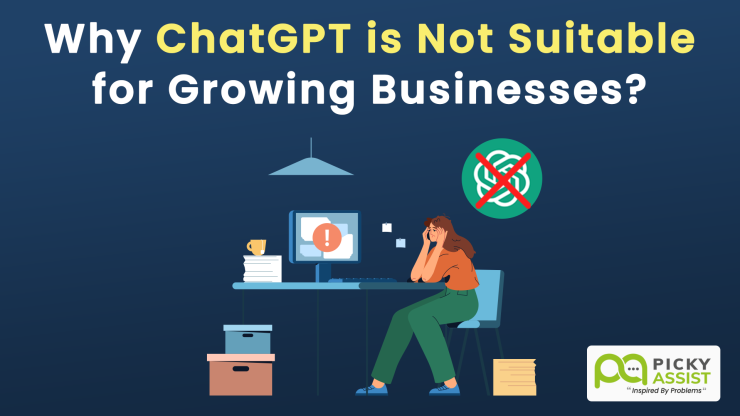


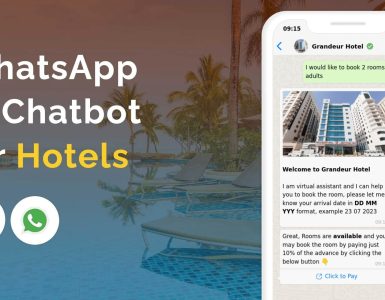
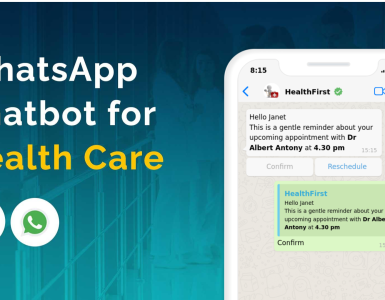
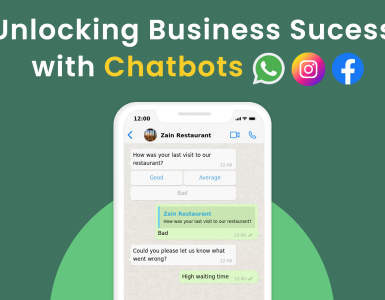
Add comment